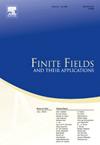维数为 4 的 NMDS 代码的四个新系列及其应用
IF 1.2
3区 数学
Q1 MATHEMATICS
引用次数: 0
摘要
对于 [n,k,d]q 线性编码 C,C 的单子缺陷由 S(C)=n-k+1-d 定义。当 S(C)=S(C⊥)=1 时,代码 C 被称为近最大距离可分离(NMDS)代码,其中 C⊥ 是 C 的对偶代码。NMDS 代码在有限投影几何、设计和秘密共享方案中有着重要的应用。在本文中,我们提出了四种维数为 4 的 NMDS 码无穷族的新构造,并完全确定了它们的权枚举器。作为应用,我们还确定了这些 NMDS 码对偶码的局部性,并得到了四个距离最优和维度最优的局部可恢复码族。本文章由计算机程序翻译,如有差异,请以英文原文为准。
Four new families of NMDS codes with dimension 4 and their applications
For an linear code , the singleton defect of is defined by . When , the code is called a near maximum distance separable (NMDS) code, where is the dual code of . NMDS codes have important applications in finite projective geometries, designs and secret sharing schemes. In this paper, we present four new constructions of infinite families of NMDS codes with dimension 4 and completely determine their weight enumerators. As an application, we also determine the locality of the dual codes of these NMDS codes and obtain four families of distance-optimal and dimension-optimal locally recoverable codes.
求助全文
通过发布文献求助,成功后即可免费获取论文全文。
去求助
来源期刊
CiteScore
2.00
自引率
20.00%
发文量
133
审稿时长
6-12 weeks
期刊介绍:
Finite Fields and Their Applications is a peer-reviewed technical journal publishing papers in finite field theory as well as in applications of finite fields. As a result of applications in a wide variety of areas, finite fields are increasingly important in several areas of mathematics, including linear and abstract algebra, number theory and algebraic geometry, as well as in computer science, statistics, information theory, and engineering.
For cohesion, and because so many applications rely on various theoretical properties of finite fields, it is essential that there be a core of high-quality papers on theoretical aspects. In addition, since much of the vitality of the area comes from computational problems, the journal publishes papers on computational aspects of finite fields as well as on algorithms and complexity of finite field-related methods.
The journal also publishes papers in various applications including, but not limited to, algebraic coding theory, cryptology, combinatorial design theory, pseudorandom number generation, and linear recurring sequences. There are other areas of application to be included, but the important point is that finite fields play a nontrivial role in the theory, application, or algorithm.

 求助内容:
求助内容: 应助结果提醒方式:
应助结果提醒方式:


